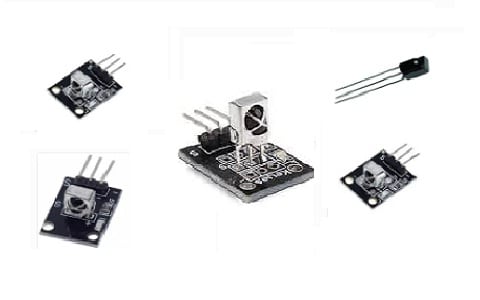In today’s world of remote-controlled systems, IR (Infrared) receiver modules play a vital role in enabling wireless communication between electronic devices. Whether you are building a home automation system, a DIY electronics project, or an industrial sensor network, IR receiver modules help decode signals from standard remote controls. This article compares five of the most popular IR receiver modules: KY-022, TSOP382, HX1838, VS1838B, and TL1838, focusing on their features, specifications, w … [Read more...]
DIY Solar USB Phone Charger : Step-by-Step Guide
In a world increasingly reliant on sustainable energy, creating your own DIY solar-powered USB charger is not only a great eco-friendly project but also an excellent way to understand basic electronics. Whether you're an engineering student, hobbyist, or eco-conscious traveler, this project is simple, affordable, and doesn’t require advanced skills. This article provides brief information on a DIY solar USB phone charger step-by-step procedure. What is a Solar USB Phone Charger? A Solar USB C … [Read more...]
DIY USB Fan Powered by a Temperature Sensor
This article explains how to design a DIY USB fan that is powered by a temperature sensor. Additionally, it provides instructions on how to use a temperature sensor (LM35 or DHT11) to trigger a fan, how to power the project via USB, how to build a control circuit using a transistor, and how to test, calibrate, and upgrade the system. DIY USB Fan Powered by a Temperature Sensor The required components to make this DIY USB fan powered by a temperature sensor include the following. … [Read more...]
Capacitive Sensor : Formula, Working , Types, Circuit, Interfacing & Its Applications
A proximity sensor is an electronic device, used to sense or detect the presence or approach of nearby objects without physical contact. So these sensors change the data on the object’s presence or movement into an electrical signal. Generally, detection systems are available in three types of systems that perform this conversion. The systems that utilize the eddy currents that are generated within metallic sensing objects through electromagnetic induction, the systems that notice changes within … [Read more...]
Image Sensor : Working, Types, Specifications, Characteristics, Interfacing & Its Applications
Image sensor plays a key role in digital cameras to provide high-resolution images. So developments in this sensor technology assist undo blurring within images and permit us to capture accurate photos in exposure and depth. Image sensing has a long history from the first daguerreotype film cameras to the analog film rolls to expose them within the 20th century. Image sensors are becoming more computational and influencing advances within machine learning, image & signal processing to become … [Read more...]
GIS Quick Reference
What is GIS? GIS is a system designed to capture, store, analyze, manage, and present spatial or geographic data. It integrates various data sources to create layered maps and provide insights into geographic patterns and relationships. Components of GIS: Hardware: Computers, GPS devices, scanners, printers, and other peripherals used to collect, store, and process spatial data. Software: GIS software like ArcGIS, QGIS, and Google Earth is used for data manipulation, analysis, and … [Read more...]
Nyquist Criteria : Theory, Calculations, Applications, Sample Problems
The Nyquist Criteria stands as a main principle in the realm of digital communication, delineating the fundamental relationship between the sampling rate and the bandwidth of a signal. Named after the renowned engineer Harry Nyquist, this criterion has profound implications for various aspects of communication system design, from ensuring faithful signal representation to mitigating aliasing effects. In this comprehensive exploration, we delve into the Nyquist Criteria, elucidating its … [Read more...]
Choosing the Right Diode for ESD Protection: Key Parameters, Case Studies, Types
Electrostatic Discharge (ESD) poses a significant threat to electronic devices and integrated circuits. ESD events can generate high voltages and currents, potentially causing irreparable damage to sensitive components. Implementing robust ESD protection is crucial in ensuring the reliability and longevity of electronic systems. One key component in ESD protection circuits is the diode. This article we will look into the essential factors to consider before diode selection for ESD protection, … [Read more...]
TRIAC : Basics, Structure, Working, States, Circuit, VI Characteristics & Its Applications
Triode for Alternating Current, or TRIAC, stands as an important semiconductor device in the realm of electronics, especially in applications where precise control over alternating current (AC) power is paramount. From dimmer switches to motor speed control systems, these devices find their place in a diverse array of applications. In This article we will look into the working principles of TRIACs, shedding light on their operational intricacies. Furthermore, we will explore the considerations … [Read more...]
8051 Microcontroller Cheat Sheet
A concise set of notes which is used mainly for quick reference is known as a cheat sheet or crib sheet. These sheets were used by many students to prepare/ revise for their exam/test. The cheat sheet provides you with very useful data regarding a subject and helps you remember. This article provides brief information on the 8051 microcontroller cheat sheet which includes the information about the microcontroller. 1. Introduction: The 8051 microcontroller is an 8-bit microcontroller with … [Read more...]
- 1
- 2
- 3
- …
- 23
- Next Page »









